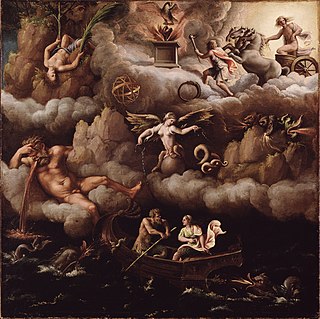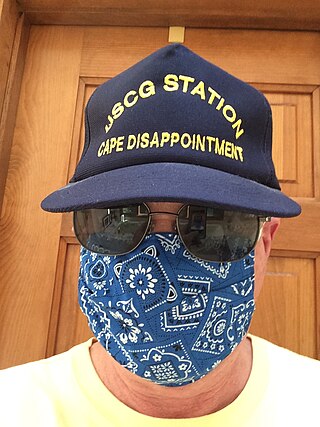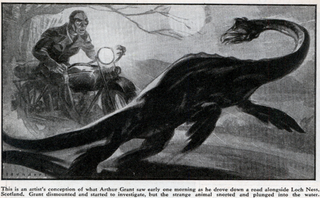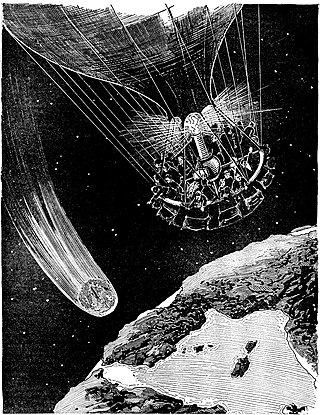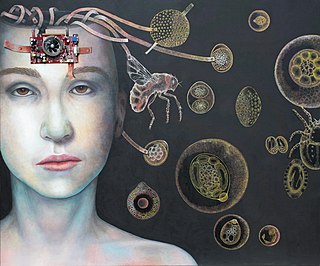Aliens
Gary Westfahl wrote that Stanisław Lem and other writers use a standard argument: that "science fiction writers, as human beings, are inherently incapable of imagining truly alien beings, meaning that all aliens in science fiction are nothing but disguised humans." [36]
Various works of science fiction have described aliens disguised in human form. [2] [37]
The theme of alien infiltration in human form appeared commonly during the Cold War. [38] Jack Finney's 1955 novel The Body Snatchers , and the films made from it, involve aliens not only looking generally human, but replacing specific human beings, an intensely frightening prospect because one's own neighbors, friends, and family must now be suspected. It has been suggested that this conveyed the paranoia of the McCarthy era. [39]
The various incarnations of Star Trek had numerous aliens capable of impersonating humans, for example the Salt Vampire of "The Man Trap", Trelane the Squire of Gothos, the Organians in "Errand of Mercy", the re-created historical combatants in "The Savage Curtain", among others from the original series; the Changelings (Odo's people) in Deep Space Nine ; and the Suliban in Enterprise .
David Buxton's From The Avengers to Miami Vice discusses the use of human disguise in The Invaders , [40] suggesting that though it might at first glance appear to be an extraterrestrial representation of the communist threat the show also picks up on deeper doubts regarding the American value-system.
The theme of infiltration continued in popularity into the closing stages of the Cold War in the 1980s. In the science fiction series V , the reptilian aliens wear human suits to pass as humans, trying to make humans feel more comfortable around them. [41] They Live deviated from the cold-war fear of communists by having its alien infiltrators be the capitalist elite, exploiting mindnumbed consumers [42] while The Thing featured a more visceral biological horror, with an alien that would infect and duplicate hosts. [43] In the 1982 British sci-fi film Xtro , an alien spaceship abducts a father and an alien returns disguised as him. The alien rapes a woman and she gives birth to a fully grown man in what author Barbara Creed describes as being a primal "phantasy" where man is born fully grown and completely independent of its mother. [44]
In the CW television series Supernatural practically all the supernatural creatures the protagonistic Winchester brothers encounter can assume human form, although there are a few exceptions to this, such as the Shtriga and the Wendigo. Most noticeable with the "human disguises" in the show are that of angels and demons. The true forms of angels are brilliant, amazing and overwhelming, as well as being as high as New York skyscrapers, forcing angels to possess humans whenever they manifest on Earth. The true forms of demons are destructive and deadly, forcing demons to forcibly possess humans. Other creatures, such as shapeshifters and the Leviathans, need samples of humans to take on their form.
Recently DC: The New Frontier returned to the cold war theme, using the character of the Martian Manhunter, "a shape-changing alien who adopts human disguise because he knows his alien form would scare people", to look back at cold-war paranoia and fear of outsiders. [45]
In Roald Dahl's novel The Witches the titular creatures, the Witches, are effectively evil demons which assume human form. In their human form, they do not really fit comfortably within their human disguises, and even when they disguise themselves as human, they have several giveaway clues which can only be identified by truly observant individuals. Such individuals have formed an organization called Witchophiles who are dedicated to hunting down and killing the evil demons. In their human forms, witches have unnatural eyes, which flash ice and fire, and also they have long felinstic claws which they disguise with gloves. Their most notable feature is their bald heads, which they disguise with first-class wigs.
In Pandemic's 1950s-themed Destroy All Humans! video game, the Furon character Crypto, a gray-skinned alien, uses a holographic human disguise to infiltrate suburban United States. "In human form he cannot use weapons but is still able to use his mental powers to hurl objects and hypnotize people into becoming obedient slaves." [46]
Some authors portray the mannerisms of aliens using human disguises as awkward, indicating that the aliens may not feel comfortable in their false skins, [47] for instance Vincent D'Onofrio's portrayal of an alien "Bug" wearing a human suit in Men In Black . [48]
Aliens in human disguise do not always have sinister motives: in Meet Dave , a group of aliens arrive in a spaceship shaped like a human being, and pilot it, to interact with the humans without getting noticed. In Starman the alien appears in human form, explaining it was so "you not be a little bit jumpy." In the Men in Black movie and comic book, alien immigrants disguised as humans inhabit the Earth; [49] the alien prince of the Arquillian Empire lives as a human being with a pet cat.
Galaxy Quest and 3rd Rock from the Sun also use the meme. 3rd Rock from the Sun features a group of aliens given human bodies to observe aspects of human society.
An episode of Buffy the Vampire Slayer incorporates a praying mantis in human disguise, posing as a substitute high-school teacher who seduces her students before eating them. The mantis in disguise serves as a metaphor to suggest to younger viewers that rushing unprepared into sexual activity can result in being "devoured". [50]
In the film Mimic , insects native to Earth are genetically modified to stop a cockroach-borne disease, but as a side-effect later evolve in size and shape to mimic and prey upon human beings.
In Marvel Comics the Skrull, a race of aliens, commonly disguise themselves as humans to move about unnoticed on Earth.
A particularly notable and riveting form of human disguise appears in Larry Niven's Ringworld , specifically in the minor religion practiced by the Kdaptists, a religious order of Kzin who believe that the pinnacle of creation is not Kzin but man, and adopt a mask of human skin during prayer to attempt to trick God into thinking they are His children. [51] [52]
Robots
Isaac Asimov considered humanoid robots (androids) in the novel Robots and Empire and the short stories "Evidence" and "The Tercentenary Incident", in which robots are crafted to fool people into mistaking them as human. Some of Asimov's robots respond to human distrust and antipathy by passing as human and influencing human development for its own good. In Asimov's novella The Bicentennial Man , the robot Andrew gradually replaces his mechanical body with organic components, but only on the 200th anniversary of the start of his organic conversion, when he allows his positronic brain to "decay" and thus abandons his immortality, does he become accepted as "human".
In the movies A.I. Artificial Intelligence , and the Alien series, robots are made to look and act human. In The Terminator , Arnold Schwarzenegger played a cyborg that wore a human disguise. [53]
In the 2010 Metroid game, the antagonist is a cyborg named Madeline Bergman who has been raised by the governing Galactic Federation and has effectively been kept in imprisonment on a derelict space vessel, thus making her gradually loathe humans. Madeline eventually plans to raid the Federation headquarters and destroy human civilization, but fortunately Samus Aran is called onto the scene by the Federation before this can occur.
The various Star Trek shows also had persuasive androids, for instance in the original series episodes "What Are Little Girls Made Of?", "Shore Leave", "I, Mudd", and "Requiem for Methuselah".
In Star Trek: The Next Generation , the android Data's desire to become more human became an ongoing source of commentary on the human condition. [54] (Data's positronic brain is a nod to Asimov's stories.) An earlier pilot-film by Star Trek's creator Gene Roddenberry, The Questor Tapes , had featured an android left on 20th-century Earth as the last of a series of advanced alien technology, with the same subtext.
In Philip K. Dick's novel Do Androids Dream of Electric Sheep? and its film adaption Blade Runner , the replicants are biological robots indistinguishable from humans except by specialised testing of their empathic reactions. [55] As those androids are manufactured exclusively for off-world colonies on Mars and are illegal on Earth they attempt to disguise as human to evade their killing by special police operatives.
Similarly in the remade series Battlestar Galactica , robots known as the Cylons have evolved the ability to make bodies that appear quite human. [56] When killed, they transfer their consciousness from one body to an identical model elsewhere. This seeming immortality, the uncertainty of who is really human and who is Cylon, and the love between characters who are revealed to be human or Cylon, are used for discussion of what it means to be human. [57]
Pretenders in Transformers are Autobots and Decepticons who encase their robotic bodies in organic-like outer shells. While most Decepticons use shells patterned after monsters, most Autobots use shells that appear human.




